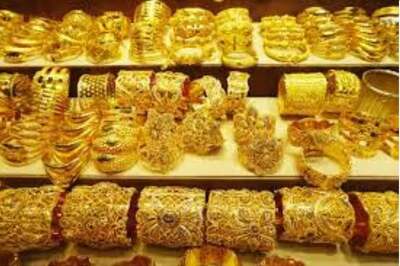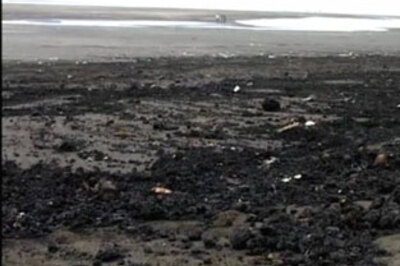
views
What is uranium glass?
Uranium glass uses uranium as a colorant in the glass mixture. The uranium in uranium glass is what causes these pieces to glow under a black light—and it's that glow that makes these pieces so popular. While they might be beautiful just sitting on a shelf, they're even better in the dark with just a black light shining. Uranium glass does emit radiation, although it's a very small amount. Even a relatively large collection of uranium glass wouldn't pose any danger to people near it. Uranium glass emits alpha and beta rays, which are pretty weak radiation waves that can be stopped by a single pane of glass.
Identifying Uranium Glass
Shine a blacklight on the piece to see if it glows. Point a portable blacklight at the piece and if it contains uranium, it will glow a bright green. Some pieces glow brighter than others, but as long as a piece glows, you know for sure that you've got a genuine piece of uranium glass. While you may have seen cartoon or comic book depictions that suggest otherwise, uranium doesn't glow because of radiation—it glows because of its chemical composition. You can't tell how much radiation is in the glass based on how bright it glows—the brightness of the glow depends on the chemical mixture the manufacturers used. Some uranium glass pieces might not glow because the manufacturers added other colorants or chemicals to the glass mix that cover it up (although this is really rare).
Check the name of the product or talk to the seller. If you're buying from an individual seller or antiques dealer, chances are they know a lot about the pieces they're trying to sell—just ask! They might even have a black light you could use if you don't happen to have one handy. The name of the glassmaker, their location, and the year the piece was produced can sometimes tell you definitively if it's uranium glass. For example, any glass produced in the U.S. after 1970 isn't uranium glass.
Check the radiation level with a Geiger counter. If the piece glows, use a Geiger counter to find out how much radiation the piece is emitting. Simply hold the Geiger counter near the piece and check the readout. Keep in mind that the levels of radiation in some of these pieces are so low they won't even register—but you'll likely get a faint reading if you hold the Geiger counter really close to the piece.
FAQs about Uranium Glass
What's the difference between uranium glass and Vaseline glass? Vaseline glass is a type of uranium glass that has a distinctive yellow color. In fact, the name comes from the fact that it looks a lot like petroleum jelly. Uranium glass can be many different colors, as well as either transparent or opaque. Vaseline glass, as a specific variety, is always the same color and always translucent. If you're having trouble telling the difference, just think of it this way: all Vaseline glass is uranium glass, but not all uranium glass is Vaseline glass.
When was most uranium glass made? Uranium glass was first produced in the 1830s and was relatively popular until the 1930s. With the onset of World War II, uranium was needed for other purposes, causing a steep decline in uranium glass production. Uranium glass made a comeback in the 1950s and 1960s, especially with American glassmakers. This glass had extremely low percentages of uranium compared to the earlier pieces.
Is uranium glass still produced? Yes! While there are very few producers of uranium glass left in 2024, there are still a few around the world, making mostly novelty items. The percentage of uranium in these pieces is considerably lower than it was before World War II. Uranium glass hasn't been produced in the U.S. since 1970. So, for example, if someone tells you they have a piece of uranium glass made in the U.S. in 1984, you know that isn't possible. Either they're wrong about when and where the glass was made, or it's not real uranium glass (no blacklight needed).
Is uranium glass dangerous? Not really. While you are exposing yourself to trace amounts of radiation when you touch, wash, or use uranium glass, you're actually exposed to a lot more radiation just living your daily life. Historically, there were no regulations that limited the amount of uranium manufacturers could include in their glass. While it's usually under 2%, some pieces are as much as 25% uranium.
Is uranium glass food-safe? No, you shouldn't eat or drink out of uranium glass. Even though the amount of radiation emitted is very small, the U.S. Environmental Protection Agency (EPA) warns against this because you could ingest microscopic uranium particles along with your food or drink. Uranium glass pieces are generally considered safe to touch and handle, as long as they're not obviously chipped or broken. Regardless of the uranium content, antique glass includes many other chemicals, such as arsenic, that make pieces unsafe for anything other than display.
Where can you find uranium glass? Antique shops and thrift stores are your best bet since most of the uranium glass out there was produced before the 1940s. Check out uranium glass forums to find out the best locations to search for uranium glass pieces to start or expand your collection. For a lot of collectors, the appeal of uranium glass is in the search—half the fun is holding a black light up to ordinary-looking pieces in hopes of that tell-tale glow.
Is uranium glass expensive? Like any collectible, some uranium glass pieces are quite valuable to collectors. But if you're just interested in picking up a couple of pieces for the novelty value, you can probably find them without breaking the bank. Thrift stores, yard sales, and estate sales are great places to start. You might even be able to get some pieces super cheap if they're being sold by people who don't realize what they've got or that they could get more for it. Avoid online auction or resell sites because you have no way to check for the presence of uranium before you buy the piece (and photos can be faked). There are also lots of online forums and groups for uranium glass enthusiasts if you're looking for more pieces or want to share your growing collection.




















Comments
0 comment